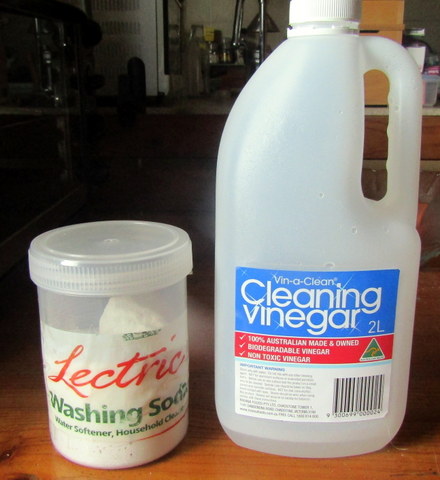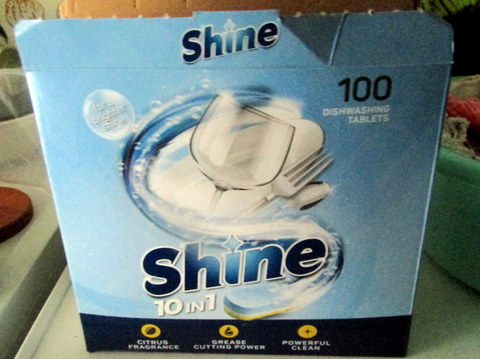When I put the constructed wetland greywater system in for the laundry, I designed it to take the effluent from both the washing machine and the dishwasher. However, seeing as we were using commercial dishwashing tablets I chickened out on running the dishwasher effluent into the constructed wetland and always ran it to waste. I did some research on making our own but never got to a conclusion, other projects seeming to be more important. Then a while ago, one of our guys at Permaculture Sydney West did a talk on water and how important it is and it motivated me to re-activate my project to make our own Dishwashing powder or tablets. I did some reading and trialling and this was what I came up with.
Context: My lovely partner in the sustainable life laid down two absolute requirements for anything I came up with –
1. It had to be effective, and
2. It had to not rot out the guts of the dishwasher.
Oh, ye of little faith!
What’s out There
I like simple things, but a lot of the DIY dishwasher tablets/powder had a number of ingredients, some of which I failed to understand what their purpose was in the formulation, so I needed to do a bit more research.
The majority of formulations contained some combination of these components:
• Washing soda AKA sodium carbonate or soda ash
• Baking soda AKA bicarb, sodium bicarbonate, sodium hydrogen carbonate
• Citric acid
• Salt
• Borax
• Liquid soap of some description
• Vinegar
• Colours and flavours (essential oils etc)
It seemed to me that mixing alkaline components (washing soda, bicarb, soap, borax) with acidic components (Citric acid, vinegar) would cause the one in the lesser amount be reacted out by the component in the greater quantity in the formulation. Anyway….
So why is all that stuff in there? It turns out that:
Washing soda is a heavy lifter in the cleaning department, and quite alkaline.
Bicarb is like detuned washing soda, not so alkaline but not so good a cleaner or degreaser either.
Citric acid takes hard water (water containing calcium and magnesium salts) deposits and keeps them suspended in the wash water. This may be important elsewhere, but Sydney’s water is soft. It also reacts with the alkaline components and can reduce their effectiveness, so it will probably work better in the rinse aid section that the main cleaner section.
Salt (sodium chloride) is also a water softener, but a very weak one and chlorides can cause issues with stainless steel or iron components being washed.
Borax is a weak alkali and less effective and raising the pH of the water in the cleaning cycle than washing soda or bicarb. It is also quite toxic, so it works against what I am trying to achieve in getting the dishwasher effluent to be able to be safely put through the constructed wetland and on to the garden.
Liquid soap is quite often added as a surfactant to assist with cleaning, but again, it is much less effective than washing soda (notice a pattern here?) and usually is only present in very small amounts.
Vinegar will also react with the alkaline cleaners and reduce their effectiveness, but is great for removing sediment or deposits happening during the cleaning process from your dishes and glassware. To this end it should be added to the rinse aid compartment, thus cleaning any deposits off your dishes after the cleaning process is completed.
In terms of colours and flavours you add what you want in the way of essential oils etc, to give the detergent a fresh smell. Personally, I don’t see the point. I have heard that citrus based essential oils (grapefruit, lemon, lime, orange) as well as adding a nice smell by including limonene in the mix they also act as a solvent to help remove fatty deposits. However, depending on the type of essential oil you use it can contain anywhere between 30% and 98% limonene, and usually it is only added at around 10 to 20 drops per batch of cleaner, which would translate to only a drop or two per dishwasher load, I suspect its effect is marginal at best. (It does smell nice though!)
Conclusion
So, my conclusion from all of this was to use the very cheap, effective and readily available washing soda as the cleaner and then to add vinegar to the rinse aid dispenser of our dishwasher.
The next decision however, was how much of each to add?
On the washing soda side, I weighed the tablets we are currently using and came up with each one weighing 19 grams, so I weighed out 19 grams of washing soda and placed it into the dispenser. The vinegar was another matter, because historically we had not used rinse aid much so I didn’t know how much to add in. Well, as those of you wise in the ways of dishwashers will already know, it turns out you just pour some into the rinse aid dispenser and it then dispenses the required amount to each wash. Who knew?
We tried it out and I certainly couldn’t pick any difference in the cleanliness of the dishes coming out of our regular cycle between our home made and the commercial cleaner. Winner!
Addendum
There is always something else!
While continuing my random researches I was having a look through Jackie French’s book “Household Self-sufficiency” and low and behold, on page 94, down the bottom of the page, under the heading of ‘Dishwasher Liquid’, Jackie settles all arguments with – “Use a quarter to half a cup of washing soda per cycle (the harder your water the more washing soda you will need). Add a few dessertspoons of white vinegar to the rinse cycle to stop streaking.”
Note to self: Always consult Jackie FIRST!
Please note: Some manufacturers of dishwashers discourage the use of vinegar, so check with your manual to ensure it is OK.





